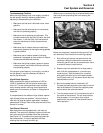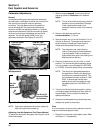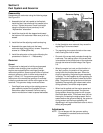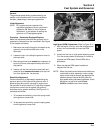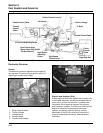
5.10
Section 5
Fuel System and Governor
Reassembly
Reassemble the carburetor using the following steps.
See Figure 5-9.
1. Assemble the fuel inlet needle to the float tab.
Install the float, float shaft and inlet needle to the
air horn. Tighten the screw. Check float height
using the procedure found previously in the
‘‘Adjustments’’ subsection.
2. Install the slow jet with the stepped end toward
the bottom of the carburetor. Make sure jet is fully
seated.
3. Install the low idle adjusting needle and spring.
4. Assemble the upper body onto the lower
carburetor body using the four screws. Torque the
screws to 1.7 N·m (15 in. lb.).
5. Install the carburetor on the engine following the
procedures in Section 11 – ‘‘Reassembly.’’
Governor
General
The governor is designed to hold the engine speed
constant under changing load conditions. Most
engines are equipped with a centrifugal flyweight
mechanical governor. Some engines utilize an optional
electronic governor, which is shown and covered on
page 5.12 and 5.13. The governor gear/flyweight
mechanism of the mechanical governor is mounted
inside the crankcase and is driven off the gear on the
camshaft. This governor design works as follows:
• Centrifugal force acting on the rotating governor
gear assembly causes the flyweights to move
outward as speed increases. Governor spring
tension moves them inward as speed decreases.
Figure 5-9. Governor Linkage.
• As the flyweights move outward, they cause the
regulating pin to move outward.
• The regulating pin contacts the tab on the cross
shaft causing the shaft to rotate.
• One end of the cross shaft protrudes through the
crankcase. The rotating action of the cross shaft
is transmitted to the throttle lever of the carburetor
through the external throttle linkage. See Figure
5-9.
• When the engine is at rest, and the throttle is in
the “fast” position, the tension of the governor
spring holds the throttle plate open. When the
engine is operating, the governor gear assembly
is rotating. The force applied by the regulating pin
against the cross shaft tends to close the throttle
plate. The governor spring tension and the force
applied by the regulating pin balance each other
during operation, to maintain engine speed.
• When load is applied and the engine speed and
governor gear speed decreases, the governor
spring tension moves the governor arm to open
the throttle plate wider. This allows more fuel into
the engine, increasing the engine speed. As the
speed reaches the governed setting, the governor
spring tension and the force applied by the
regulating pin will again offset each other to hold a
steady engine speed.
Adjustments
NOTE: Do not tamper with the governor setting.
Overspeed is hazardous and could cause
personal injury.
Cross Shaft
Governor Spring
Governor Arm
Throttle
Linkage
Hex. Nut






